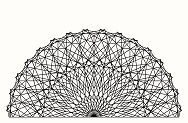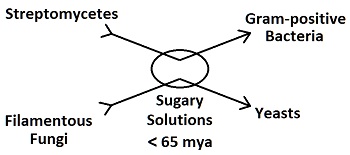


 |
 |
 |
There is no description of the drastic break and transformation of terrestrial biology, as if evolution kept doing what it was always doing but without the dinosaurs. Before the break, mammals were locked into small rodent-like creatures for more than a hundred million years. They could not diversify or get larger. Flowering plants were so rare they were invisible in the fossil record until the 1990s. Yeasts, gilled mushrooms and gram positive bacteria did not exist. Afterwards, all terrestrial species ballooned rapidly into immensely diverse species. It's necessary to understand why dinosaurs were large to understand what was happening as modern biology took form. Theories look to dinosaurs to find an advantage to being large. That's not how evolution works. Evolution is an adaptation to change in environmental conditions, which means it's the environment that has to be evaluated to determine causes of evolution. The dinosaur environment would have been overwhelming brush in the lowlands. Dinosaurs had to tromp through that brush, which would have required a lot of power, size and weight. Dinosaurs ate nonwoody brush, at least until some of the predators evolved, and they too would have had to tromp through the same brush. Trees only existed as conifers on the hills; and flowering plants were so rare that they were not known to exist at that time until recently. The reason for the inconspicuous types would have been that only a small amount of space between the conifers and the brush would have been available for diverse alternatives. The brush was holding back all evolution. Mammals were small, as they moved under and through the brush instead of over it. The smallness of mammals shows that the brush was too overwhelming for them to get larger. Only grass had the characteristics required to subdue the nonwoody brush. Grass was evolving before the dinosaurs died out, as indicated by an unusual dinosaur that evolved toward the end of their era—Anzu wyliei. It was smaller and long-legged, like a large chicken. The long-leggedness says it was adapting to grass. Grass is what keeps weeds from growing now days. It has two major advantages over other nonwoody plants. One, it forms a mat near the surface which crowds out other species; and two, it can absorb water above the ground as well as through extended roots. The long leaves of grass are adapted for catching dew drops which run down the blades to the point where water is absorbed. If there hadn't been an asteroid strike and resulting super volcano, grass would have slowly subdued the nonwoody brush. But it happened very rapidly, because grass could survive the upheaval far better than other species. In fact, the other species were becoming inadequately adapted due to the inability to evolve forward. Oppressive brush was holding back all evolution. Grass freed up evolution for modern species which adapted rapidly to the improved environment creating a high degree of diversity. Grass allowed space for flowering plants which diversified and evolved into a new type of trees. The new trees had broad leaves for gathering sunlight effectively, where the confers had needly leaves to maximize surface area for absorbing carbon dioxide. As flowering plants were given more space by the friendly grass, they evolved sugary solutions and fruit as a method of harnessing the activity of insects and animals. A lot of biology evolved from the sugary solutions. Molds moved into the sugary solutions and evolved into yeasts. Soil bacteria (Streptomycetes) moved into the sugary solutions and evolved into a new type of bacteria called Gram-positive.  The Streptomycetes are filamentous bacteria which have cell walls similar to molds, which indicates that they started as fungi which adapted to soil. Growing in soil caused the fungi to become prokaryotic, as simplification and reduced size would speed up growth. It would be possible for an existing bacterium to borrow cell wall characteristics from a mold through horizontal gene transfer; but that is probably not what happened, because the filamentous nature of Streptomycetes indicates a major break from other bacteria. Highly complex and diverse biochemistry also points to fungi origins. Streptomycetes would have adapted to the soil as soon as suitable soil existed, which was 541 million years ago. Much evidence indicates that clay was layered over a shale-derived surface at the time of the Cambrian event 541 million years ago. This result occurred when a planet exploded where the asteroid belt exists between Mars and Jupiter. Not only was clay added to the surface, but there would have been critical minerals added to the surface and oceans which had been depleted through precipitation. The very shallow layer of clay over the surface of the earth indicates that the clay was layered on long after other geological processes had been occurring. Claiming that soil forms from plant roots breaking down rocks through acid is an insult to scientific knowledge. Soil had to exist before there could be plant roots. Filamentous fungi evolved into gilled mushrooms, as soil conditions became suitable with grass shoving out the nonwoody brush. The only mushrooms that existed during dinosaur years were the puffball and bolete. They are very primitive, lacking external spores. They both have extremely unusual tissue which removes all flavor as a method of reducing the tendency of animals eating them. The bolete produces a desirable flavor after it ages, so spores will be eaten and carried around; but the lack of flavor during early growth requires extremely demanding biochemistry which modern mushrooms could never achieve. Evolutionary change was much easier to produce in early times when there was less specialization and competition. The whimsicalness of molds in producing clamp connections shows this. Remnants of ancient evolution are still around, as evolution does not remove residual effects when there is no selective advantage. Modern species are so specialized and competing that they are on the verge of becoming extinct due to an inability to adapt. With a lot of complex, interdependent relationships at the biochemical and social levels, rigidness is acquired, and change becomes disruptive. All biology would differentiate into extinction within a few million years, even if humans had no influence over it.
|
|
|||||||||||||||||
 |
 |
 | ||
 |
 |
 |
||